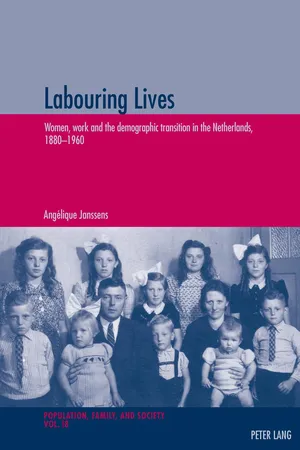
- 314 pages
- English
- PDF
- Available on iOS & Android
About this book
Labouring Lives unravels the huge changes which have so fundamentally altered the life courses of ordinary women over the past one hundred and fifty years, namely the changes in marriage and fertility patterns. Using dynamic data from Dutch population registers and analytical techniques from the life course approach, the book offers new evidence on women's changing position in the labour market, their role in pre-nuptial sexuality, and their contribution to marriage and fertility change in the Netherlands between 1880 and 1960. The author reconstructs the socio-economic and demographic worlds of different groups of working and non-working women, and by doing so she is able to locate the various groups driving the changes. Advanced statistical tools enable the author to analyse differences in fertility strategies, stopping versus spacing, employed by various social and cultural groups in the Netherlands. This book leads to conclusions which challenge a number of orthodoxies in the field.
Frequently asked questions
- Essential is ideal for learners and professionals who enjoy exploring a wide range of subjects. Access the Essential Library with 800,000+ trusted titles and best-sellers across business, personal growth, and the humanities. Includes unlimited reading time and Standard Read Aloud voice.
- Complete: Perfect for advanced learners and researchers needing full, unrestricted access. Unlock 1.4M+ books across hundreds of subjects, including academic and specialized titles. The Complete Plan also includes advanced features like Premium Read Aloud and Research Assistant.
Please note we cannot support devices running on iOS 13 and Android 7 or earlier. Learn more about using the app.
Information
Table of contents
- Cover
- Contents
- List of Tables
- List of Figures
- List of Appendices
- Preface
- 1. Women and the demographic transition
- 2. Context, data and methods
- 3. Women, work and occupational careers
- 4. Work, marriage and prenuptial sexuality
- 5. Women, work and fertility
- 6. Conclusions
- References
- Appendices